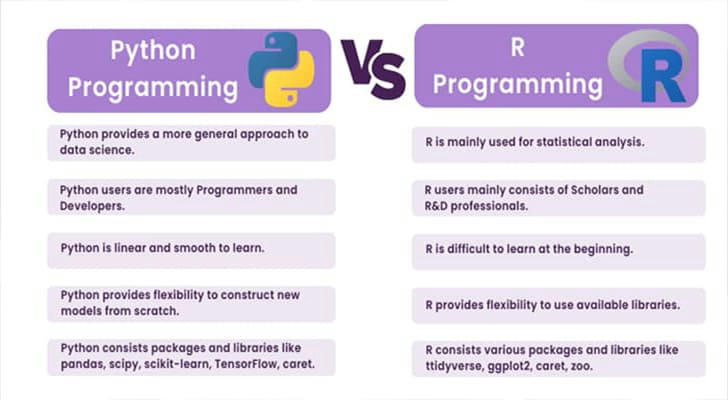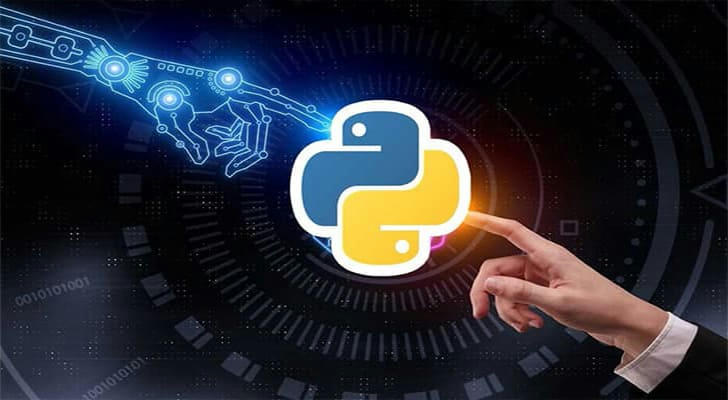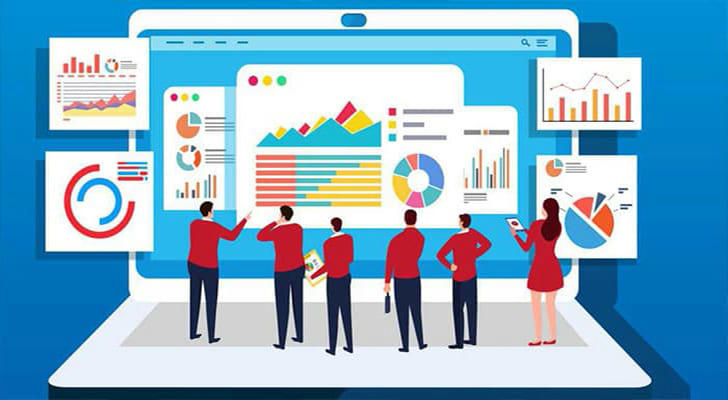Learning data analysis from scratch, how to choose between Python and R?

Data analysis, a fascinating field, has attracted countless people. Python and R, as an indispensable assistant for data analysis, each has a large user base. So, for beginners, which language is more suitable for getting started? This article will reveal the answer for you.Used cars are often seen as the most cost-effective option, with good quality at a reasonable price. However, why do most people end up losing rather than gaining when buying used cars? This may be due to some myths about used cars that many people hold. This article summarizes three of the most common myths, hoping to remind guys who are considering buying a used car. Keep reading!
Comparison between Python and R
Python and R are like two best friends in the world of data analysis, each with its own unique strengths. Choosing between them is a bit like choosing your favorite ice cream flavor.It's up to you which one you prefer!
•Python is more like a versatile all-rounder. It can do data analysis, build websites, and even power artificial intelligence. Its syntax is simple and easy to understand, making it a great choice for beginners. Plus, the Python community is incredibly active, so you can always find help when you need it.
• R is more like a statistics expert. It's great for complex statistical analyses and creating stunning visualizations. If you're really into statistics or want to do some cutting-edge data visualization, R is the way to go. However, its syntax can be a bit more complex, so it might take some time to get used to.
So, which one should you choose?
• If you're a beginner and want to get started with data analysis quickly: Python is a great choice. Its learning curve is relatively gentle.
• If you're really interested in statistics or want to do research: R is a better fit for you.
• If you want to try both: That's even better! Many data scientists use both Python and R, after all, the more tools in your toolbox, the better.
Imagine you want to analyze a sales dataset.
• Python: It's like a Swiss Army knife, with a wide range of functions. You can use it to clean data, visualize data, and even build machine learning models to predict future sales. For example, you can use Pandas to handle data, Matplotlib or Seaborn to create beautiful plots, and Scikit-learn to build linear regression models.
• R: It's like a toolbox specifically designed for statisticians, with a variety of statistical tools. If you want to delve deep into the statistical properties of your data, R is an excellent choice. For example, you can use dplyr to manipulate data, ggplot2 to create stunning plots, and the lm function for linear regression analysis.
Now, let's say you want to analyze social media data.
• Python: You can use Tweepy to scrape Twitter data and NLTK for text analysis to understand user sentiment.
• R: You can use rtweet to scrape Twitter data and tidytext for text analysis.
In conclusion, no language is perfect. The most important thing is to find the tool that works best for you and have fun exploring data!

Python: The All-Rounder for Data Analysis
Python is like a Swiss Army knife for data analysis. It can do everything from data cleaning and visualization to machine learning and web development. The best part? It's incredibly easy to learn! The syntax is simple and straightforward, making it perfect for beginners. Plus, the Python community is super helpful and supportive.
Python is great for:
•Data cleaning and preparation: Think of it as tidying up your data before you analyze it.
• Data visualization: Creating beautiful and informative charts to help you understand your data.
• Machine learning: Teaching computers to learn from data, like image recognition or predicting the future.
• Data mining: Discovering hidden patterns in large datasets.
If you're looking to learn data analysis, Python is an excellent choice!
John is a freshman who has just started programming. He wants to use programming to analyze the stock data he has collected. He chose Python as his entry language. By learning the basic syntax of Python, he quickly mastered how to read data, clean data, and calculate stock returns. With the help of the Pandas library, he easily visualized the data and intuitively showed the trend of stock prices.

R: Your Statistical Analysis Powerhouse
R is a versatile and powerful tool for data analysis, particularly suited for those with a strong interest in statistics. It's like having a Swiss Army knife for your data, offering a wide range of tools to tackle various tasks.
When to Use R:
• Statistical Analysis: R excels at crunching numbers and uncovering patterns in data. Whether you're testing hypotheses, running ANOVAs, or building regression models, R has you covered.
• Data Visualization: Want to turn your data into stunning visuals that tell a story? ggplot2, an R package, is your go-to. It lets you create customized plots that are both informative and visually appealing.
• Bioinformatics: R is a popular choice for biologists studying genes, proteins, and more. Its powerful statistical tools and libraries make it a great fit for analyzing biological data.
• Financial Analysis: From risk assessment to portfolio optimization, R can help you make informed decisions in the world of finance.
Who Should Learn R?
• Statisticians: If you're a statistician, R is an essential tool in your toolkit. It's designed to handle complex statistical analyses with ease.
• Data Analysts: R can help you dive deeper into your data and uncover hidden insights.
• Researchers: Whether you're in academia or industry, R can be a valuable asset for your research projects.
• Statistics Enthusiasts: Even if you're not a professional statistician, R is a great way to explore data and learn more about statistics.
Why Choose R?
• Powerful Statistics: R offers a wide range of statistical functions and packages to suit your needs.
• Stunning Visualizations: ggplot2 lets you create beautiful and informative plots that help you communicate your findings effectively.
• Active Community: The R community is large and supportive, providing plenty of resources and help.
• Extensibility: R can be customized with packages to meet your specific needs.
In summary, R is a powerful tool for anyone who wants to delve deeper into data analysis, especially those with a strong interest in statistics. It's a versatile language that can be used for a wide range of tasks, from basic data cleaning to advanced statistical modeling. So, if you're ready to unlock the power of your data, R is the way to go!
R is a powerful tool for statistical computing and data analysis. It's especially suitable for those interested in statistics or who need to perform in-depth statistical analysis. If you want to extract maximum value from your data, R is an excellent choice.
A biomedical researcher is studying the effect of a new drug on tumor cell growth. He collected a large amount of gene expression data and analyzed it using R. First, he used R's statistical functions to perform exploratory analysis on the data to understand the distribution characteristics of the data. Then, he used linear models and analysis of variance to compare the differences in gene expression between different experimental groups. Finally, he used ggplot2 to draw clear and intuitive visualization charts to show the experimental results. Through the powerful functions of R, the researcher successfully discovered new biomarkers, providing important basis for drug development.
R or Python, which one is right for me?
So which one should I choose?
Depends on your interests: If you like statistics, choose R; if you like programming, choose Python.
Depends on your goals: If you want to be a data scientist, it is best to learn a little bit of both.
Depends on the community: Both R and Python have large communities. You can go and see which community is more active and has more information.
To sum up:
R is more suitable for in-depth data analysis, just like a statistics expert.
Python is more general and can do a lot of things, like an all-round player.
The most important thing is to find the right tool for yourself, and then keep learning and practicing.
Choosing a programming language is like choosing an idol. There is no absolute right or wrong, only the one that suits you better.
If you like to delve into data and want to uncover the truth behind the data, R is like your academic mentor, helping you build a data analysis kingdom.
If you like hands-on practice and want to let data serve you, Python is like your universal tool, which can help you solve various data problems.
So, how do you choose?
• Ask yourself: Do you prefer exploring the world of data like Hadley Wickham or changing the world with code like Wes McKinney?
• Give it a try: Check out Hadley Wickham's "R for Data Science" or Wes McKinney's "Python for Data Analysis" to get a feel for their style.
• Don't stress: It's okay if you make the "wrong" choice. The goal is to learn.
No matter which language you choose, I hope you become the next Hadley Wickham or Wes McKinney!

Conclusion
The choice between Python and R depends on your interests and goals. If you enjoy programming and are more interested in machine learning, Python is a good choice. If you are more interested in statistical analysis, R is a better option. But regardless of your choice, the most important thing is to find a learning style that suits you and stick with it.
